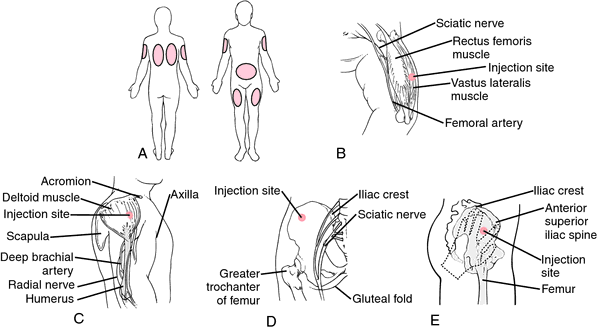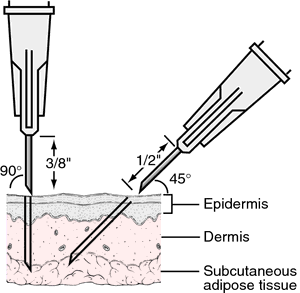injection
(redirected from interseptal injection)Also found in: Dictionary, Thesaurus, Encyclopedia.
injection
[in-jek´shun]Immunizing substances, or inoculations, are generally given by injection. Some medicines cannot be given by mouth because chemical action of the enzymes and digestive fluids would change or reduce their effectiveness, or because they would be removed from the body too quickly to have any effect. Occasionally a medication is injected so that it will act more quickly. In addition to the most common types of injections described below, injections are sometimes made into arteries, bone marrow, the spine, the sternum, the pleural space of the chest region, the peritoneal cavity, and joint spaces. In sudden heart failure, heart-stimulating drugs may be injected directly into the heart (intracardiac injection).

Injections into the anterolateral aspect of the thigh are considered the safest because there is less danger of damage to a major blood vessel or nerve. The area permits multiple injections, is more accessible, and is easier to stabilize, particularly in pediatric patients or others who are restless and uncooperative. The vastus lateralis muscle is located by identifying the trochanter and the side of the knee cap and then drawing a visual line between the two. The distance is then divided into thirds and the needle inserted into the area identified as the middle third.
The needle should be long enough to insure that the medication is injected deep into the muscle tissue. The gauge of the needle depends on the viscosity of the fluid being injected. As a general rule, not more than 5 ml is given in an intramuscular injection for an adult. The maximum for an infant is 0.5 ml, and the injection is made into the vastus lateralis muscle. The needle is inserted at a 90-degree angle to the skin. When the gluteus maximus muscle is the site chosen for the injection, the patient should be in a prone position with the toes turned in if possible. This position relaxes the muscle and makes the injection less painful.

in·jec·tion
(in-jek'shŭn),injection
(ĭn-jĕk′shən)injection
Forced adminstration of a fluid usually understood to be by needle. See Bolus injection, Intracellular sperm injection, Intrathecal injection, Intravenous injection, Nipent® (pentostatin) injection, Therapeutic injection.in·jec·tion
(in-jek'shŭn)injection
(in-jek'shon) [ inject]Patient care
All supplies used in preparing and administering an injection should be sterile. The caregiver chooses the appropriate syringe size for the volume of fluid to be injected, the appropriate needle gauge for the type of fluid, and the appropriate needle length for the administration route and site, considering the amount of muscle and adipose tissue, mobility limitations, and other site-related factors. Hands should be thoroughly cleansed before and after the procedure, and gloves worn if preparing a chemotherapeutic agent. The prescribed dose is accurately measured. An appropriate site is identified by using anatomical landmarks, and the area is cleansed with an antiseptic swab (from the center outward) and time allowed for the antiseptic to evaporate. The needle is inserted at the appropriate angle, given the prescribed route. Intradermal injections use a short fine needle with the opening faced upward; the needle is placed nearly parallel to the surface of the skin and advanced far enough for the injected fluid to make a small bubble under the skin, then carefully removed; pressure that could cause the fluid to leak out onto the skin surface should be avoided. Subcutaneous injections should consist of no more than 1 ml. A short needle should be inserted at a 45° angle, without aspiration, and gentle pressure or no pressure applied to the site after needle removal. After insertion into muscle (the needle is inserted directed into the muscle, at a 90° angle), the syringe plunger is aspirated to ensure that no blood returns to prevent accidental injection into a blood vessel. The prescribed medication is injected slowly, then the needle is removed, and pressure is applied to the site with a dry sponge. A Z-track method helps to ensure that the medication remains in the muscle as desired and does not leak back into subcutaneous tissues. When administering an intravenous (IV) injection, the syringe is aspirated and blood obtained to be certain the needle is in the vein. When removing a needle after administering an IV injection directly into the vein, the caregiver lessens the chance of bleeding into soft tissue by applying firm pressure with a dry sponge while elevating the site above the heart for several minutes. However, the vast majority of intravenous injections are administered through an IV catheter or an IV fluid port with a needle or needleless device. Pressure is not applied when removing this device. The needle should not be recapped; both the needle and syringe should be disposed in a “sharps” container according to protocol. The injection time and site, any untoward responses to the injection, desired effects, and adverse reactions to the particular drug injected are recorded.
depot injection
dextrose and sodium chloride injection
epidural injection
fractional injection
hypodermic injection
intra-alveolar injection
intracardial injection
intracytoplasmic sperm injection
Abbreviation: ICSIintradermal injection
intralingual injection
intramuscular injection
CAUTION!
To avoid injury, newborn intramuscular injections should be administered in the middle third of the vastus lateralis muscle using a 5/8-in, 25-gauge needle.intraosseous injection
Intraosseous infusion.intraperitoneal injection
intravenous injection
Solutions
Many liquid preparations are given by intravenous infusion. Those commonly used include isotonic saline, Ringer's lactate, dextrose 5% in sterile water, hyperalimentation fluids, lipids, vitamins, and numerous medications. The solution may be given continuously or by intermittent or bolus injection. The rate of infusion varies with the patient's needs.
Site
Intravenous infusion usually is given through a vein in the hand or arm, but central veins or other peripheral veins may be used as indicated.
Note
In patients with collapsed veins, it may be possible to make the veins apparent by placing a tourniquet around the arm or leg and then inserting a 23- or 25-gauge catheter into a tiny superficial vein. Instillation of sterile intravenous fluid into the vein while the catheter is in place will distend the entire larger vein proximal to the small vein. A larger needle or catheter can then be inserted into the larger vein.
iodinated I 131 albumin injection
iodipamide meglumine injection
iodohippurate sodium I 131 injection
iothalamate meglumine injection
iron dextran injection
CAUTION!
Because of the risk of anaphylaxis, a test dose should be given before starting an infusion of iron.jet injection
lethal injection
parathyroid injection
posterior pituitary injection
protein hydrolysate injection
rectal injection
sclerosing injection
selenomethionine Se 75 injection
spinal injection
subcutaneous injection
vaginal injection
vasopressin injection
Z-track injection
injection
The introduction of any substance, especially medication or nutritional substances, into the body, usually by means of a hollow needle and a syringe. Injections may be given into the skin (intradermally), under the skin (subcutaneously), into a muscle (intramuscularly), into a vein (intravenously), into an artery (intra-arterially), into the SUBARACHNOID SPACE or into a sheath (intrathecally), or into an organ. The term is also sometimes used to refer to the introduction of substances into a body orifice such as the URETHRA, the vagina or the rectum.Injection
injection
ciliary injection Redness (almost lilac) around the limbus of the eye caused by dilatation of the deeper small blood vessels located around the cornea. It occurs in inflammation of the cornea, iris and ciliary body, and in angle-closure glaucoma. Each of these conditions is associated with loss of vision and usually pain. Syn. ciliary flush. See ocular decongestant; red eye; pericorneal plexus.
conjunctival injection Redness (bright red or pink) of the conjunctiva fading towards the limbus due to dilatation of the superficial conjunctival blood vessels occurring in conjunctival inflammations. There is no loss of vision but ocular discomfort and no pain. See ocular decongestant; red eye; thyroid ophthalmopathy; pericorneal plexus.
intravitreal injection Injection into the eye posterior to the limbus and directed towards the vitreous. It may be used to administer medication, corticosteroids (e.g. triamcinolone), an antiviral agent (e.g. ganciclovir) in extremely severe ocular inflammations, usually of a purulent nature, to inject antibiotics (e.g. amikacin, ceftazidime, vancomycin) immediately after vitrectomy, or to inject anti-VEGF drugs in the treatment of wet age-related macular degeneration.
peribulbar injection Injection of a local anaesthetic (e.g. bupivacaine, lidocaine, procaine) around the globe (either single or multiple injections) to produce anaesthesia of the globe and periocular tissues, as well as paralysis of the extraocular muscles. Peribulbar injection may also be used to administer medication (e.g. corticosteroids) in posterior segment inflammation. Syn. peribulbar block.
retrobulbar injection Injection of a local anaesthetic into the muscle cone behind the eye to produce anaesthesia of the globe and periocular tissues, as well as paralysis of the extraocular muscles. It is used less commonly than peribulbar block. Syn. retrobulbar block.
subconjunctival injection A method of administering medication (e.g. antibiotics, corticosteroids, mydriatics) postoperatively, or in acute anterior segment inflammations. An area of conjunctiva away from the limbus is lifted to form a bleb and an injection is made into it.
sub-Tenon's injection Injection of a local anaesthetic near or beyond the equator using a cannula, which has been inserted under the conjunctiva and Tenon's capsule a few mm from the limbus and slid posteriorly to produce anaesthesia of the globe as well as paralysis of the extraocular muscles. A sub-Tenon's injection may also be used to administer medication (e.g. corticosteroids) in posterior segment inflammation.
in·jec·tion
(in-jek'shŭn)Patient discussion about injection
Q. Why is insulin injected and not taken as a pill?
Q. I received a corticosteroid injection in my left knne th A.M. Knee is all stiff & swollen. Is this normal?
Q. My arm became limp after flu shot & have had pain in arm. Vaccine itself or improper injection? Any advice? I could not move my arm about 3 hours after the injection. It took about 3 days before I could raise my arm at all. It became painful to use and has bothered me for a couple of months. The doctor gave me a cortisone shot which helped some but not completely. He had never seen this reaction before. Is it a reaction to the vaccine or could it be the way it was injected? Is their anyone who has had or knows of a similar case?

